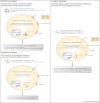Infection, inflammation and exercise in cystic fibrosis
- PMID: 23497303
- PMCID: PMC3599254
- DOI: 10.1186/1465-9921-14-32
Infection, inflammation and exercise in cystic fibrosis
Abstract
Regular exercise is positively associated with health. It has also been suggested to exert anti-inflammatory effects. In healthy subjects, a single exercise session results in immune cell activation, which is characterized by production of immune modulatory peptides (e.g. IL-6, IL-8), a leukocytosis and enhanced immune cell functions. Upon cessation of exercise, immune activation is followed by a tolerizing phase, characterized by a reduced responsiveness of immune cells. Regular exercise of moderate intensity and duration has been shown to exert anti-inflammatory effects and is associated with a reduced disease incidence and viral infection susceptibility. Specific exercise programs may therefore be used to modify the course of chronic inflammatory and infectious diseases such as cystic fibrosis (CF).Patients with CF suffer from severe and chronic pulmonary infections and inflammation, leading to obstructive and restrictive pulmonary disease, exercise intolerance and muscle cachexia. Inflammation is characterized by a hyper-inflammatory phenotype. Patients are encouraged to engage in exercise programs to maintain physical fitness, quality of life, pulmonary function and health.In this review, we present an overview of available literature describing the association between regular exercise, inflammation and infection susceptibility and discuss the implications of these observations for prevention and treatment of inflammation and infection susceptibility in patients with CF.
Figures


References
-
- Haskell WL, Lee IM, Pate RR, Powell KE, Blair SN, Franklin BA, Macera CA, Heath GW, Thompson PD, Bauman A. Physical activity and public health: updated recommendation for adults from the American College of Sports Medicine and the American Heart Association. Circulation. 2007;116(9):1081–1093. - PubMed
-
- Walsh NP, Gleeson M, Shephard RJ, Gleeson M, Woods JA, Bishop NC, Fleshner M, Green C, Pedersen BK, Hoffman-Goetz L, Rogers CJ, Northoff H, Abbasi A, Simon P. Position statement. Part one: Immune function and exercise. Exerc Immunol Rev. 2011;17:6–63. - PubMed
Publication types
MeSH terms
LinkOut - more resources
Full Text Sources
Other Literature Sources
Medical

